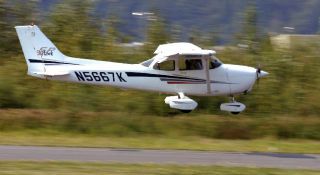In 1969, the Pacific Northwest cheered on the Seattle Pilots, Neil Armstrong first set foot on the moon, and Auburn celebrated the opening of its Municipal Airport.
While Federal Aviation Administration (FAA) guidelines have changed a bit in 39 years, the airport’s taxi-way system has not. It is too narrow, presenting a safety hazard to planes.
Now, thanks to a $2.5 million FAA grant, the city will widen the taxi-way system, bringing the fourth busiest commuter airport in the state up to date.
City officials said they will take the money and fill in the area between the runway and the taxi strip, giving the planes a wider path to get to the landing and takeoff strip.
Airport Manager Jamelle Garcia said the work, anticipated in the airport’s 10-year master plan, is scheduled to start next summer and take about 30 days.
Garcia said that since the airport opened, there have been changes to FAA guidelines calling for separation from the runway to accommodate the different kinds of aircraft.
“Auburn is classified as a B-1 small airport because the west taxi-way is too close to the runway center line,” Garcia said. “When the FAA changed some of their airport criteria, we fell outside the norm. You’ve got the west taxiway that goes along the runway side, and it is southbound only, and we have a northbound only on the east side. They are not very wide. For instance, most multi-engine aircraft come very close to hitting the lights.”
In fact, Garcia said, some of the larger aircraft won’t even use the taxi-ways. They will just stop on the runways, turn around, and exit at center field where it is wide enough to do so.
For these reasons, the west- and east-side taxi-ways will be removed and replaced with one taxi-way, featuring wider turnouts to allow for those occasions when there is not enough clearance for planes to pass each other.
The airport will post signs explaining who has the right of way.
Lewis said these improvements are all about safety.
“The air is more crowded, and there can’t be a lot of circling of planes unable to come in. You have to be able to get in and out, and you have to be able to do it safely. This gives us more safety features. And it most likely will allow some expansion of the airport as far as covered hangars because it is becoming more and more used, not just a place to fly in and out of,” Lewis said.
“…This puts in some more safety equipment, and it gives the rest of that funding for safety improvements to make it easier to land and take off,” Lewis said.
As the FAA grant covers 97 percent of the cost of the reconstruction, the state and city will divide the cost of the remaining 3 percent down the middle.
Garcia said the city will use airport-generated funds for its contribution to the work, and will not ask taxpayers for a dime.
“When you get an FAA grant, it’s a 97-percent grant. The only condition is if you ever want to dispose of an airport, you have to pay back all the 97 percent,” Lewis said.


